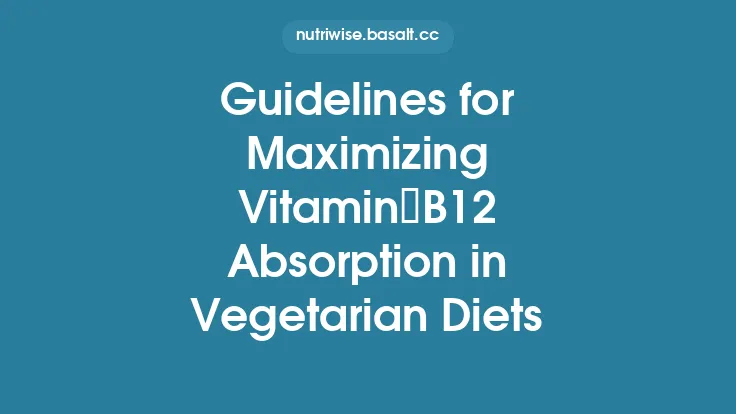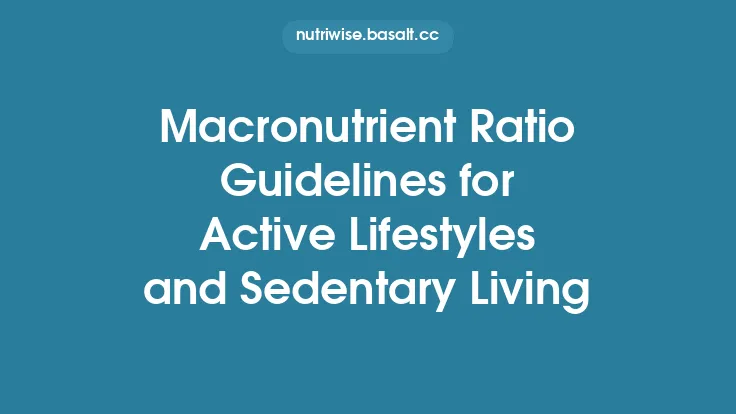Nutrient bioaccessibility—the proportion of a nutrient that is released from food and becomes available for absorption in the gastrointestinal tract—is a cornerstone of effective diet planning. While the composition of individual foods matters, the way those foods are assembled into meals, the timing of consumption, and the physiological environment created by lifestyle choices collectively determine how much of the ingested nutrients actually reach the bloodstream. This article presents a set‑by‑step framework for designing balanced diet plans that systematically maximize nutrient bioaccessibility, drawing on current scientific understanding while remaining practical for everyday use.
Understanding Bioaccessibility Within Whole‑Diet Planning
Bioaccessibility differs from bioavailability in that it focuses on the *release* of nutrients from the food matrix during digestion, whereas bioavailability also incorporates cellular uptake and metabolic utilization. In the context of a complete diet, the goal is to create conditions that favor the efficient liberation of vitamins, minerals, phytonutrients, and macronutrients across all meals. Key considerations include:
- Nutrient Density vs. Nutrient Load – Prioritize foods that deliver high amounts of essential nutrients per gram (e.g., leafy greens for vitamin K, fatty fish for omega‑3 fatty acids) while avoiding excessive caloric load that can slow gastric emptying.
- Complementary Food Groups – Assemble meals that combine sources of macronutrients (protein, carbohydrate, fat) in proportions that support optimal digestive enzyme activity (e.g., 15–30 % of total calories from protein, 45–65 % from carbohydrates, 20–35 % from fat).
- Digestive Phase Alignment – Align the presence of specific nutrients with the phase of digestion in which they are most readily liberated (e.g., fat‑soluble vitamins released during the emulsification phase in the duodenum).
By treating the diet as an integrated system rather than a collection of isolated foods, planners can anticipate how each component influences the overall bioaccessibility landscape.
Strategic Meal Sequencing to Enhance Nutrient Release
The order in which foods are consumed within a single eating occasion can markedly affect the mechanical and chemical processes that drive nutrient liberation.
| Sequence | Rationale | Expected Impact |
|---|---|---|
| Start with a small portion of acidic fruit or a splash of citrus juice | Lowers gastric pH, stimulating pepsin activity and promoting protein denaturation | Improves release of protein‑bound amino acids and certain minerals |
| Follow with a balanced plate containing protein, complex carbohydrate, and healthy fat | Provides substrates for pancreatic enzymes (proteases, amylases, lipases) and bile salts | Facilitates simultaneous breakdown of macronutrients, enhancing co‑release of fat‑soluble vitamins |
| Conclude with a modest amount of fermented or probiotic‑rich food | Introduces exogenous enzymes (e.g., lactase, phytase) that can act on residual substrates | Increases final bioaccessibility of residual carbohydrates and phytochemicals |
Research indicates that a brief pre‑meal acidification step can increase the solubility of certain micronutrients (e.g., calcium, magnesium) without specifically targeting mineral pairing strategies. The emphasis here is on creating a digestive milieu that is primed for broad nutrient release rather than focusing on any single nutrient class.
Optimizing Digestive Conditions Through Lifestyle Choices
Beyond the composition of meals, everyday habits shape the physiological environment in which digestion occurs.
- Regular Physical Activity – Moderate aerobic exercise (30 min, 3–5 times/week) stimulates gastrointestinal motility, reducing transit time and preventing nutrient sequestration in the lumen.
- Adequate Sleep – 7–9 hours of quality sleep supports the circadian regulation of digestive enzymes, particularly pepsin and pancreatic lipase, which peak during the early active phase.
- Stress Management – Chronic stress elevates cortisol, which can suppress gastric acid secretion and impair bile flow, thereby lowering bioaccessibility of both water‑ and fat‑soluble nutrients. Mind‑body techniques (e.g., deep breathing, meditation) can mitigate these effects.
Implementing these lifestyle pillars creates a baseline digestive efficiency that amplifies the benefits of any dietary plan.
Leveraging Food Pairing Beyond Mineral Interactions
While mineral‑specific pairing (e.g., vitamin C with iron) falls outside the scope of this guide, broader food‑pairing concepts can still be employed to boost overall nutrient release.
- Fat‑Soluble Vitamin Synergy – Pairing carotenoid‑rich vegetables (e.g., carrots, sweet potatoes) with a modest amount of dietary fat (e.g., olive oil, avocado) enhances micelle formation, a prerequisite for absorption of vitamins A, D, E, and K.
- Protein‑Carbohydrate Interaction – Consuming a modest carbohydrate source alongside protein can stimulate the release of insulin, which in turn promotes the activity of amino acid transporters in the intestinal epithelium, indirectly supporting the uptake of co‑ingested micronutrients.
- Polyphenol‑Enzyme Modulation – Certain polyphenols (e.g., quercetin) can transiently inhibit digestive enzymes, slowing carbohydrate breakdown and allowing a more gradual release of glucose and associated nutrients. Pairing polyphenol‑rich foods with high‑glycemic items can therefore moderate post‑prandial spikes while extending nutrient exposure time.
These pairings are intended to create a harmonious digestive environment rather than to target a single nutrient.
Incorporating Fermentation and Probiotic Cultures for Enzymatic Support
Fermented foods (e.g., kefir, tempeh, kimchi) contribute live microorganisms that secrete a suite of digestive enzymes not typically present in the human gut. Their inclusion in a balanced diet plan offers several bioaccessibility advantages:
- Phytase Production – Certain lactic acid bacteria produce phytase, which hydrolyzes phytic acid, a known inhibitor of mineral release. This effect is achieved without focusing on plant‑based mineral strategies.
- Protease Activity – Fermentation can pre‑digest protein structures, reducing the reliance on gastric pepsin and pancreatic proteases, thereby enhancing the liberation of amino acids.
- Lipase Secretion – Some probiotic strains release lipases that assist in the emulsification of dietary fats, supporting the micellar solubilization of fat‑soluble vitamins.
A practical recommendation is to incorporate at least one fermented serving per day, spaced between main meals to allow the exogenous enzymes to act on residual nutrients in the gastrointestinal tract.
Timing of Supplementation and Nutrient Timing Relative to Meals
When dietary supplements are part of a balanced plan, their timing can be optimized to align with peak digestive activity.
- Water‑Soluble Vitamins (B‑complex, C) – Best taken with a light meal containing some carbohydrate to facilitate rapid gastric emptying and absorption.
- Fat‑Soluble Vitamins (A, D, E, K) – Should be consumed alongside a meal containing 5–10 g of dietary fat to promote micelle formation.
- Omega‑3 Fatty Acids – Ingested with a mixed macronutrient meal to improve incorporation into chylomicrons and subsequent transport.
- Mineral Supplements (e.g., magnesium, zinc) – Taken between meals to avoid competition with dietary phytates and to exploit the slightly higher gastric pH during fasting periods, which can improve solubility.
These timing strategies are grounded in the kinetics of digestive secretions rather than specific nutrient‑pairing protocols.
Hydration and Its Influence on Nutrient Dissolution and Transport
Adequate fluid intake is a often‑overlooked factor that directly impacts nutrient bioaccessibility.
- Gastric Dilution – Sufficient water (≈250 mL) with meals maintains optimal viscosity, allowing enzymes to diffuse freely and act on food particles.
- Intestinal Solubilization – Water serves as the solvent for the formation of micelles and mixed micelles, essential for the transport of lipophilic compounds across the unstirred water layer of the intestinal epithelium.
- Electrolyte Balance – Proper sodium and potassium levels support the activity of transport proteins (e.g., Na⁺/glucose cotransporter 1) that indirectly facilitate the uptake of co‑transported micronutrients.
A practical guideline is to aim for 30–35 mL of water per 100 kcal of food consumed, adjusting for individual sweat losses and activity levels.
Managing Gastric pH and Enzyme Activity Naturally
The stomach’s acidic environment is pivotal for the initial breakdown of proteins and the release of bound minerals. Several non‑pharmacological approaches can help maintain an optimal pH range (1.5–3.5) without resorting to acid‑supplementation:
- Chewing Thoroughly – Mechanical breakdown increases surface area, prompting a stronger gastric acid response.
- Inclusion of Mild Acidic Foods – Small amounts of apple cider vinegar or lemon juice in dressings can stimulate gastric secretions.
- Avoiding Over‑Consumption of Antacids – Frequent use of neutralizing agents can blunt the natural acid response, reducing bioaccessibility of acid‑labile nutrients.
By supporting the body’s intrinsic acid production, these practices enhance the solubilization of nutrients that require an acidic milieu for release.
Practical Planning Tools and Monitoring Bioaccessibility Outcomes
Implementing the above guidelines benefits from systematic tracking and iterative refinement.
- Meal‑Planning Software – Use platforms that allow macro‑ and micronutrient breakdown per meal, enabling the visualization of nutrient density and balance.
- Digestive Symptom Journals – Record post‑prandial fullness, bloating, or energy levels; patterns can indicate suboptimal bioaccessibility.
- Biomarker Testing – Periodic blood panels (e.g., serum vitamin D, ferritin, omega‑3 index) provide objective feedback on the effectiveness of the diet plan.
- Adjustable Templates – Create a modular meal template (e.g., “protein + complex carb + healthy fat + fermented side”) that can be populated with a variety of foods while preserving the strategic sequencing and pairing principles outlined above.
Through data‑driven adjustments, the diet plan evolves to consistently maximize nutrient release and uptake.
Concluding Perspective
Maximizing nutrient bioaccessibility is not a matter of isolated food choices but of orchestrating an entire dietary ecosystem—one that respects the timing of meals, the sequence of food consumption, the supportive role of lifestyle habits, and the subtle enzymatic contributions of fermented foods and probiotics. By applying the guidelines presented here, nutrition professionals and health‑conscious individuals can construct balanced diet plans that systematically enhance the proportion of ingested nutrients that become truly available to the body, thereby supporting optimal health outcomes over the long term.





